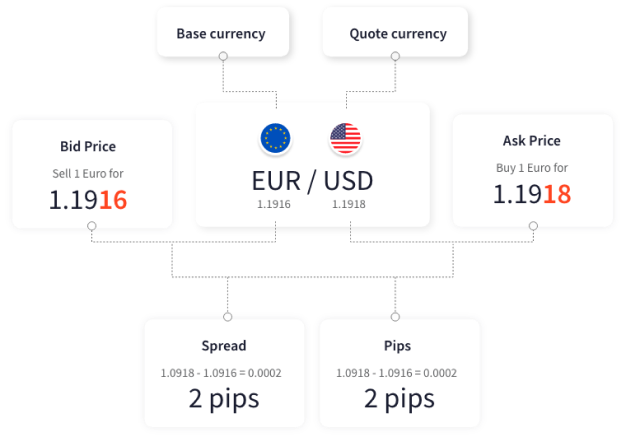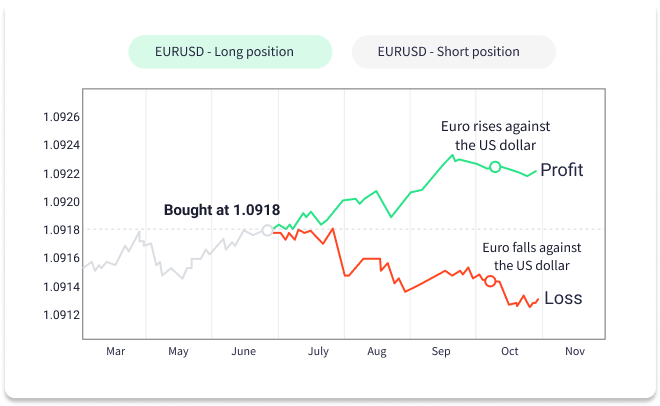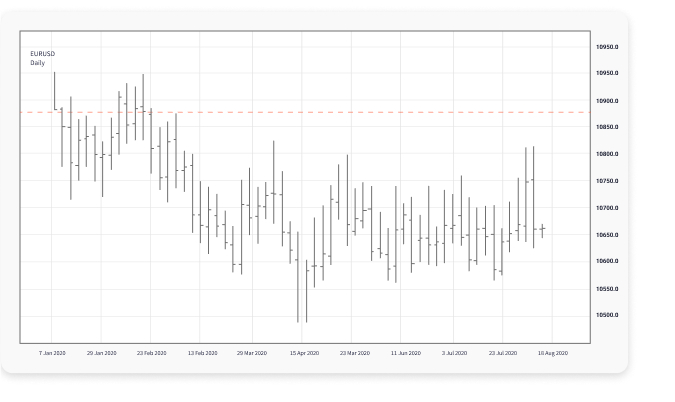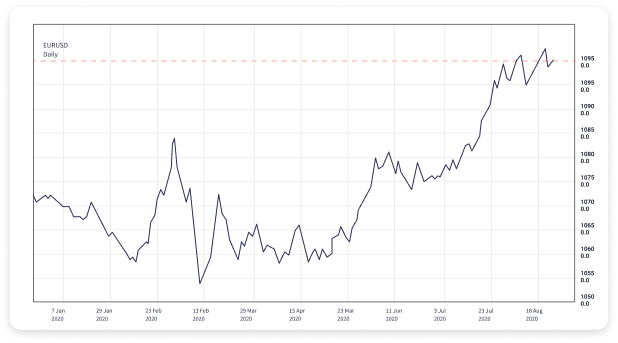
GUIDE | TRADING BASICS | BEGINNER
What is Forex trading? A beginner's guide
Learn how to become a forex trader with our comprehensive guide.
The foreign exchange market, or Forex, is the world's largest financial market. We ensure our clients are equipped with top-notch education, tools, platforms, and accounts to excel in Forex trading.
If you’re not sure where to start when it comes to forex, you’re in the right place.
You’ll find everything you need to know about forex trading, what it is, how it works and the basics to start trading.
Key takeaways
Forex trading is the trading of one currency for another to make a profit
Success in the forex market means understanding the fundamentals, picking the right broker and platform, and building a strong trading plan
Managing risks is key in forex trading. Using stop loss and take profit orders is vital to safeguard investments
What is FX?
The foreign exchange (also known as forex or FX) market refers to the global marketplace where banks, institutions and investors trade and speculate on national currencies.
An online forex broker acts as an intermediary, enabling retail traders to access online trading platforms to speculate on currencies and their price movements.
Most online brokers will offer leverage to individual traders, which allows them to control a large forex position with a small deposit. It is important to remember that profits and losses are magnified when trading with leverage.
FXTM offers a number of different trading accounts, each providing services and features tailored to a clients’ individual trading objectives.
Discover the account that’s right for you by visiting our account page. If you’re new to forex, you can begin exploring the markets by trading on our demo account, risk-free.
Forex offers many benefits to retail traders.
Forex trading allows for round-the-clock trading in various global sessions, distinct from stock markets that operate through central exchanges. This means you can jump on volatility, wherever it happens. High liquidity also enables you to execute your orders quickly and effortlessly.
Trading forex using leverage allows you to open a position by putting up only a portion of the full trade value. You can also go long (buy) or short (sell) depending on whether you think a forex pair’s value will rise or fall.
Forex trading offers constant opportunities across a wide range of FX pairs. FXTM’s comprehensive range of educational resources are a perfect way to get started and improve your trading knowledge.
How to begin forex trading
Here's everything you'll need to do to start trading forex, step-by-step.
Forex analysis explained
There are two main types of analysis that traders use to predict market movements and enter live positions in forex markets – fundamental analysis and technical analysis.
A forex trader will tend to use one or a combination of these to determine a trading style that best fits their personality.
The biggest fundamental analysis indicators
News and Economic Data
Investors and banks look for strong economies to place their funds, in the expectation that their capital will appreciate. This is because the currency of that country will be in demand as the outlook for the economy encourages more investment. Any news and economic reports which back this up will in turn see traders want to buy that country’s currency.
Central Bank and Government Policy
Central banks determine monetary policy, which means they control things like money supply and interest rates. The tools and policy types used will ultimately affect the supply and demand of their currencies. A government’s use of fiscal policy through spending or taxes to grow or slow the economy may also affect exchange rates.
Join us
Start trading with FXTM
No one makes it easier. Open an account or try our demo account to get started while you build your skills.
Understanding currency pairs
All transactions made on the forex market involve the simultaneous buying and selling of two currencies.
This ‘currency pair’ is made up of a base currency and a quote currency, whereby you sell one to purchase another. The price for a pair is how much of the quote currency it costs to buy one unit of the base currency. You can make a profit by correctly forecasting the price move of a currency pair.
FXTM offers hundreds of combinations of currency pairs to trade including the majors which are the most popular traded pairs in the forex market. These include the Euro against the US Dollar, the US Dollar against the Japanese Yen and the British Pound against the US Dollar.
You can find out more about how currency pairs work by heading to our breakdown of major currency pairs.
Forex trading, while offering substantial profit opportunities, does come with risks. The forex market tends to be more volatile than, for example, the stock market, with countless transactions taking place every minute.
It's vital to approach this market with eyes wide open, understanding that the volatility can result in significant losses just as it can lead to substantial gain. Always trade carefully and implement risk management tools and techniques, such as stop loss and take profit orders.

Essential components of currency pair trading
Base currency
The base currency is the first currency that appears in a forex pair and is always quoted on the left. This currency is bought or sold in exchange for the quote currency and is always worth 1.
Based on the example above, it will cost a trader 1.1918 USD to buy 1 EUR.
Alternatively, a trader could sell 1 EUR for 1.1916 USD.
Understanding spreads and pip in forex
Spread
As a forex trader, you’ll notice that the bid price is always higher than the ask price. The difference between these two prices is the spread. In other words, it is the cost of trading. The narrower the spread, the cheaper it costs. The wider the spread, the more expensive it is.
For example, if EUR/USD is trading with an ask price of 1.1918 and a bid price of 1.1916, then the spread will be the ask price minus the bid price. In this case, 0.0002.
In order to make a profit in foreign exchange trading, you’ll want the market price to rise above the bid price if you are long, or fall below the ask price if you are short.
Pip
A point in percentage – or pip for short – is a measure of the change in value of a currency pair in the forex market.
It is the smallest possible move that a currency price can change which is the equivalent of a ‘point’ of movement.

What is a forex trader?
A forex trader will hold a ‘position’ in a currency pair. This is the term used to describe a trade in progress and one that will have a profit or a loss, as the open position indicates the trader has some market exposure
Difference between long and short positions
A long position means a trader has bought a currency expecting its value to rise. Once the trader sells that currency back to the market (ideally for a higher price than they paid for it), their long position is said to be ‘closed’ and the trade is complete.
If you wanted to open a long position on the Euro, you would purchase 1 Euro for USD 1.1918. You will then hold your position in the hope that it will appreciate, selling it back to the market at a profit once the price has increased.
A short position refers to a trader who sells a currency expecting its value to fall and plans to buy it back at a lower price. A short position is ‘closed’ once the trader buys back the asset (ideally for less than they sold it for).
In this case, if you think the Euro will weaken against the Dollar, you will sell 1 Euro for USD 1.1916 and hold a short position. You expect the Euro to depreciate and plan to buy it back at a lower rate.
What are the most traded currency pairs on the forex market?
There are seven major currency pairs traded in the forex market, all of which include the US Dollar in the pair.
You can also trade crosses, which do not involve the USD, and exotic currency pairs which are historically less commonly traded (and relatively illiquid).
This means they often come with wider spreads, meaning they’re more expensive than crosses or majors.
Different groups of currency pairs
Major currency pairs are generally thought to drive the forex market. They are the most commonly traded and account for over 80% of daily forex trade volume.
There are four traditional majors – EURUSD, GBPUSD, USDJPY and USDCHF – and three known as the commodity pairs – AUDUSD, USDCAD and NZDUSD.
These currency pairs typically have high liquidity, which means they tend to have lower spreads. They are associated with stable, well managed economies and are less prone to slippage, where the expected price of a trade differs from the price the trade was executed at.
Cross currency pairs, known as crosses, do not include the US Dollar. Historically, these pairs were converted first into USD and then into the desired currency – but are now offered for direct exchange.
The most commonly traded are derived from minor currency pairs and can be less liquid than major currency pairs. Examples of the most commonly traded crosses include EURGBP, EURCHF, and EURJPY.
Exotics are currencies from emerging or developing economies, paired with one major currency.
Compared to crosses and majors, exotics are traditionally riskier to trade because they are more volatile and less liquid. This is because these countries’ economies can be more susceptible to intervention and sudden shifts in political and financial developments.
Join us
Start trading with FXTM
No one makes it easier. Open an account or try our demo account to get started while you build your skills.
Overview of different currency pairs
Charts in forex trading
Candlestick chart
The chart displays the high-to-low range with a vertical line and opening and closing prices. The difference to the bar charts is in the ‘body’ which covers the opening and closing prices, while the candle ‘wicks’ show the high and low.
If the candlestick is filled, then the currency pair closed lower than it opened. If the candlestick is hollow, then the closing price is higher than the opening price.


Bar chart
The whole bar represents the currency pair's whole trading range and the horizontal marks on the sides indicate the opening (left) and the closing prices (right).
Line chart
While a bar chart is commonly used to identify the contraction and expansion of price ranges, a line chart is the simplest of all charts and mostly used by beginners. It simply shows a line drawn from one closing price to the next.
When connected, it is simple to identify a price movement of a currency pair through a specific time period and determine currency patterns.

How to start trading with a forex broker
With FXTM, you can access the forex markets and execute your buy and sell orders through our trading platform.
You should always choose a licensed, regulated broker that has at least five years of proven experience. These brokers will offer you peace of mind as they will always prioritise the protection of your funds. Once you open an active account, you can start trading forex — and you will be required to make a deposit to cover the costs of your trades. This is called a margin account which uses financial derivatives like CFDs to buy and sell currencies.
It is important to remember that trading for beginners isn’t an overnight process. It takes time to become familiar with the markets and there’s a whole new vocabulary to learn. For this reason, FXTM offers a wealth of resources to learn to trade forex. For example, our Demo account is a great way to experiment with different trading strategies – but with virtual money which means with no risk attached!
Once you’re ready to move on to live trading, we’ve also got a great range of trading accounts and online trading platforms to suit you.
MetaTrader and FXTM
As a leading global broker, we’re committed to providing flexible services tailored to the needs of our clients. As such, we are proud to offer the most popular trading platforms in the world – MetaTrader 4 (MT4) and MetaTrader 5 (MT5). They are both available on a PC, Mac, mobile or tablet. Our traders can also use the WebTrader version, which means no download is required, while the MT apps for iOS and Android allow you to trade the markets on the go, anytime and anywhere.
You can use all of these platforms to open, close and manage trades from the device of your choice.
Combine tools with MetaTrader
The platforms contain a huge variety of tools, indicators and charts designed to allow you to monitor and analyse the markets in real-time. You can even build strategies to execute your trades using algorithms. Together with innovative services such as FXTM’s Pivot Point tool, Dow Jones insights, and our award-winning Customer Support team, our clients have the resources they need to trade with confidence on the platform of their choice. You can read more and download the trading platforms from our trading platforms page.
Learn forex trading
FXTM firmly believes that developing a sound understanding of the markets is your best chance at success as a forex trader. That’s why we offer a vast range of industry-leading educational resources in a variety of languages which are tailored to the needs of both new and more experienced traders.
These include Ebooks, daily market analysis, a variety of videos, and more long read guides just like this one!
There are also many forex tools available to traders such as margin calculators, pip calculators, profit calculators, foreign exchange currency converters, economic data calendars and trading signals.
Forex widgets can help to enhance your trading experience. Some of the most popular widgets include Live Rates Feed, Live Commodities Quotes, Live Indices Quotes, and Market Update widgets.
FREQUENTLY ASKED QUESTIONS
When diving into Forex trading, it’s essential to familiarize yourself with a few key terms to navigate the market effectively. Here’s a quick rundown:
Understanding these terms will help you build a solid foundation in Forex trading and make informed trading decisions.
Yes, Forex trading can indeed be a full-time job for many individuals, but it’s essential to approach it with seriousness and dedication.
Success in Forex requires not just a solid understanding of market terms and mechanics, but also consistent practice, disciplined trading strategies, and robust risk management practices. While some traders thrive on the volatility and can generate significant income, it's important to remember that Forex trading also carries risks, and losses are a part of the journey.
Those looking to make it a full-time pursuit should invest time in education and developing their trading skills, treating it like any other profession. With the right mindset and resources, Forex trading can provide a flexible and potentially rewarding career path.
Economic events play a crucial role in Forex trading, as they can significantly impact currency values. Events such as interest rate changes, inflation reports, employment statistics, and geopolitical developments affect market sentiment and perception of economic stability.
For instance, if a country’s central bank raises interest rates, its currency may strengthen due to increased foreign investment. Conversely, poor economic data can lead to a decline in currency value.
Traders often keep a close eye on an economic calendar to stay informed about upcoming events, enabling them to make well-timed decisions. Understanding how these events influence the Forex market is essential for successful trading strategies.

